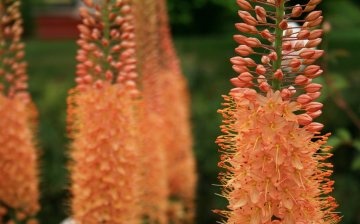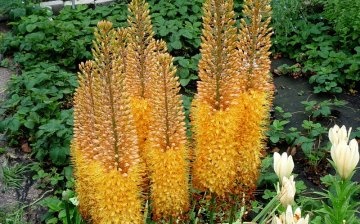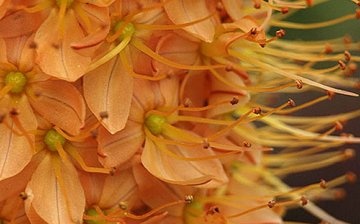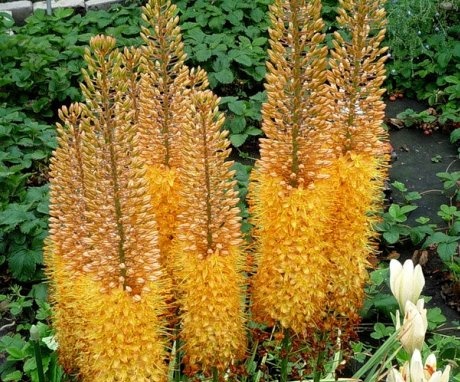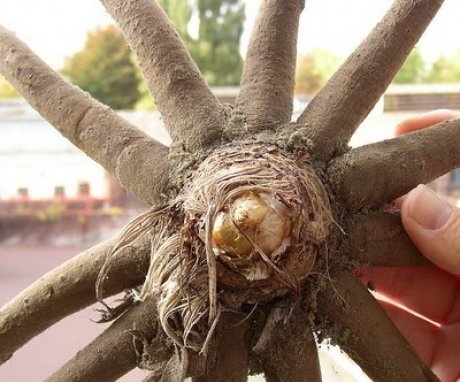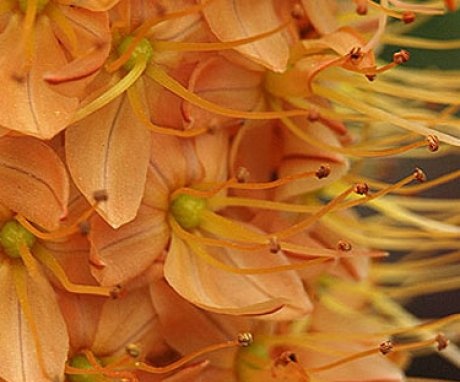Eremurus Cleopatra - a beautiful perennial in the garden
Eremurus "Cleopatra" is a rather tall and showy plant native to Asia. The stem height reaches 120 cm, and the flowers are orange-pink in color. Eremurus resembles a burning candle, since the inflorescences are collected in panicles, which are located along the length of the peduncle. From the ancient Greek language, Eremurus is translated as "tail", it is also called "Cleopatra's needle".
The root of the plant contains a polysaccharide, which in ancient times was used as glue or plaster on a wound. Young roots are suitable for eating in a boiled form. They are said to taste like asparagus. Foliage and stems are used for dyeing fabrics, mainly silk. Eremurus "Cleopatra" looks very beautiful in the garden, but keep in mind that this plant is exotic and rather difficult to grow. However, the most ambitious flower growers will be able to do this task.
Content:
How to plant an Eremurus correctly
The most successful time for planting an Eremurus is early autumn. Rhizome bulbs are the planting material. They are sold in sealed bags with peat filling inside. The roots radiate from the bulb, which should not be dry and brittle. This fact indicates poor quality raw materials.
There are usually 1 or 2 buds on the top of the bulb.
If the bud is broken off or blackened, then, most likely, such a plant will not sprout. The color of the bulb should be uniform, without any spots or rotting areas.
How to plant the bulbs:
- The landing site should be closed from drafts and well warmed up by the sun.
- The soil should be mostly dry. Suitable soil composition: turf, greenhouse soil and humus.
- When preparing the site, drainage is put in its base - gravel or pebbles, top it with soil, a layer of up to 40 cm.
- For planting, a recess of about 10-15 cm is prepared, the width should freely accommodate all the roots of the bulb. It is important that the bud remains on the surface of the soil.
- The distance between the bulbs should be between 30 and 60 cm.
- Two hours before planting, the roots of the bulb are placed in a solution of potassium permanganate. If the roots are overdried, then they are soaked with plain water. The main thing is not to submerge the kidney itself.
- After planting, sprinkle the plants with straw.
In the spring, when the plant is just beginning to grow, it needs watering... However, it is important to ensure that there is no stagnant water. Planting an Eremurus on a slope is a good solution. In case of prolonged rains, it is necessary to cover the area with a film, as the plant is harmed by waterlogging.
Plant care tips
For the lush flowering eremurus, you need to take care of regular feeding:
- The first top dressing is best done in the spring, as the plant wakes up and begins to grow actively. On a plot of 1 sq. m. make about 50 grams of complex fertilizer and 7.5 kg of manure or compost.
- The second feeding is carried out in the fall. On a plot of 1 sq. m. make about 35 grams of phosphate fertilizers. Do not exceed the dose of fertilizers, as this will only harm the plant, reducing disease resistance.
For wintering to pass without problems, Eremurus is covered with spruce branches and peat. You can build a box on top and cover it with roofing felt. Ventilation will be carried out through the side openings. After a heavy rain, the peduncle can break under the weight of the water. To prevent this from happening, it is worth taking care of the support for the plant. Plant care cannot do without loosening the soil and weeding. However, be careful not to damage the roots. Eremurus bloom depends on weather conditions. Most often this occurs in early summer, however, in rainy and cold climates, flowering may be delayed by a month or not at all.
Eremurus leaves usually dry out in summer. It is advisable to dig up such plants and store in a well-ventilated area for about three weeks. This is a very important stage for the further life of the plant. Leaving plants in the ground until the end of summer is extremely undesirable, since during this period there is a large amount of precipitation, and waterlogging can harm the eremurus.
In order for the eremurus to look spectacular on the site, it is recommended to plant a composition of five or more pieces.
They look best in the center or in the background. flower beds... This location is due to the fact that it was possible to hide the foliage that withers in summer. Eremurus gets along well with lupines, irises, milkweed and clean. And if you plant a tall onion next to it, then it will protect the eremurus from the attack of aphids. The cut eremurus is able to maintain freshness for a long time. In addition, excellent dried flowers are obtained from it, which will perfectly dilute the interior.
Reproduction methods
Reproduction of Eremurus occurs by means of seeds and a vegetative way.
How to properly collect seeds for propagation:
- Seeds are harvested only from the lower part of the inflorescence, while the upper flowers are recommended to be removed so that the plant does not waste too much energy on them.
- Ripe seeds are beige in color.
- Seed collection takes place from mid-August.
- Storage of seeds should take place in a dry and well-ventilated area.
- In September-October, the seeds are husked and ready for sowing.
- Seeds planted containers with a depth of at least 15 cm and kept in a cool dry place.
- The seed indentations should be about 2 cm.
- The first shoots appear in the spring. In the third spring, seedlings can be planted in open ground.
- Such plants will bloom only after 4-5 years.
Reproduction in a vegetative way occurs if daughter buds appear next to the main plant. You can see them already at the beginning of spring. Each kidney already has its own root system, accordingly, it is possible to separate them from the main trunk.
If the buds do not break off with light pressure, then it is worth postponing reproduction until next year. The fault must be processed ash, dry well and plant. Subsidiary plants can bloom 2 years after reproduction. Planting in a vegetative way should not be carried out more often than once every 5-6 years.
Disease and pest control
Pest control is an integral part of Eremurus cultivation. Among the variety of pests and diseases, the following can be distinguished:
- Slugs. With a small amount, you can collect them manually. If slugs have filled the area, then you should set up traps with dark beer, which will certainly attract gastropods. You can also use some spices that can scare away slugs. These include: rosemary, parsley and cilantro, allspice. Spices are scattered over the area where eremurus grow. Prevention against slugs is ash mulching. If these methods are ineffective, you can use store-bought insecticides.
- Mice and moles. Such pests damage the roots of the plant by gnawing them. Sooner or later, this leads to the death of the eremurus.In this case, it is necessary to expose the root system, removing rotten and damaged roots. Sections need to be treated with ash, let them dry and place the plant in the ground. Traps with baits are set up against mice and moles. You can use ultrasonic scarers, as well as plant on the site marigold, as their smell scares away rodents.
- Aphid is a fairly common and dangerous pest. The diseased plant stops growing, the leaves dry out, and the trunk is deformed. Aphid colonies become active at the beginning of spring. Hungry insects suck the juices from the plant and are spreading viral diseases. If you do not start fighting aphids immediately after the first signs of infection, then their active reproduction will cause great harm to the entire planting of the eremurus. Prevention against aphids is the autumn disposal of the remnants of old foliage and stems. In the spring, it is worth spraying the plants with oil and mineral compounds. In the summer, you should carefully inspect the plantings and, if aphids are found, resort to the help of insecticides.
- Spider mite. These pests live on the underside of the foliage, covering it with a cobweb. Since the mites feed on plant juices, the leaves quickly turn brown, curl up and dry out. If a tick is found, the plant must be washed with soapy water, and then sprayed with an insecticide. All dried leaves and trunks must be collected and burned.
- Rust on the leaves. Rust appears with brown-black strokes on the surface of the plant. If the disease is started, then it will disfigure all the leaves. A diseased eremurus requires treatment fungicides.
- Viral disease manifests itself as yellow spots, and the surface of the leaf itself becomes uneven. The carriers of the viral disease are aphids, bugs and other pests. Unfortunately, there is no cure for this ailment, so you should carefully monitor the plantings and prevent a massive accumulation of pests. The diseased plant should be removed and destroyed immediately so that the virus does not spread to healthy eremurus.
Knowing all the intricacies of growing eremurus, you can enjoy its unforgettable flowering on your site. Despite the fact that the plant is quite capricious in care and requires a lot of work in growing, its original and unlike anything else will noticeably decorate any landscape and attract attention.
More information can be found in the video:



